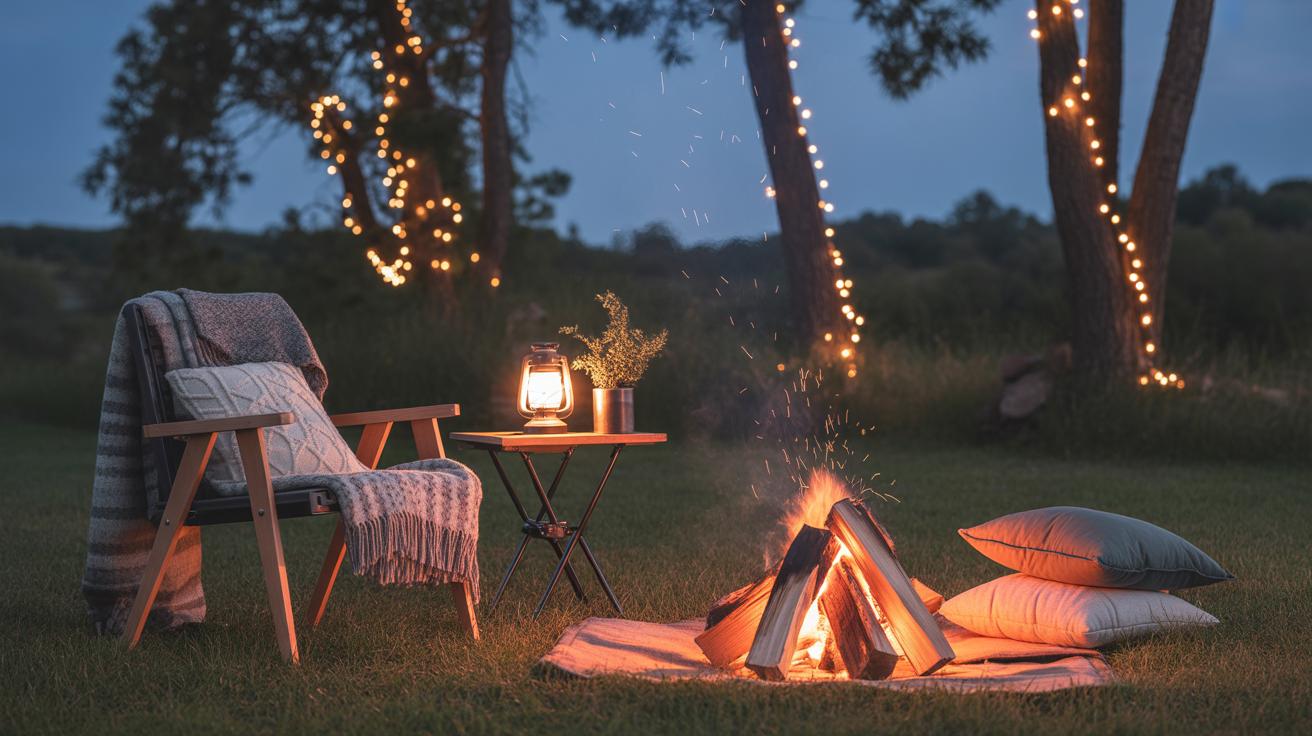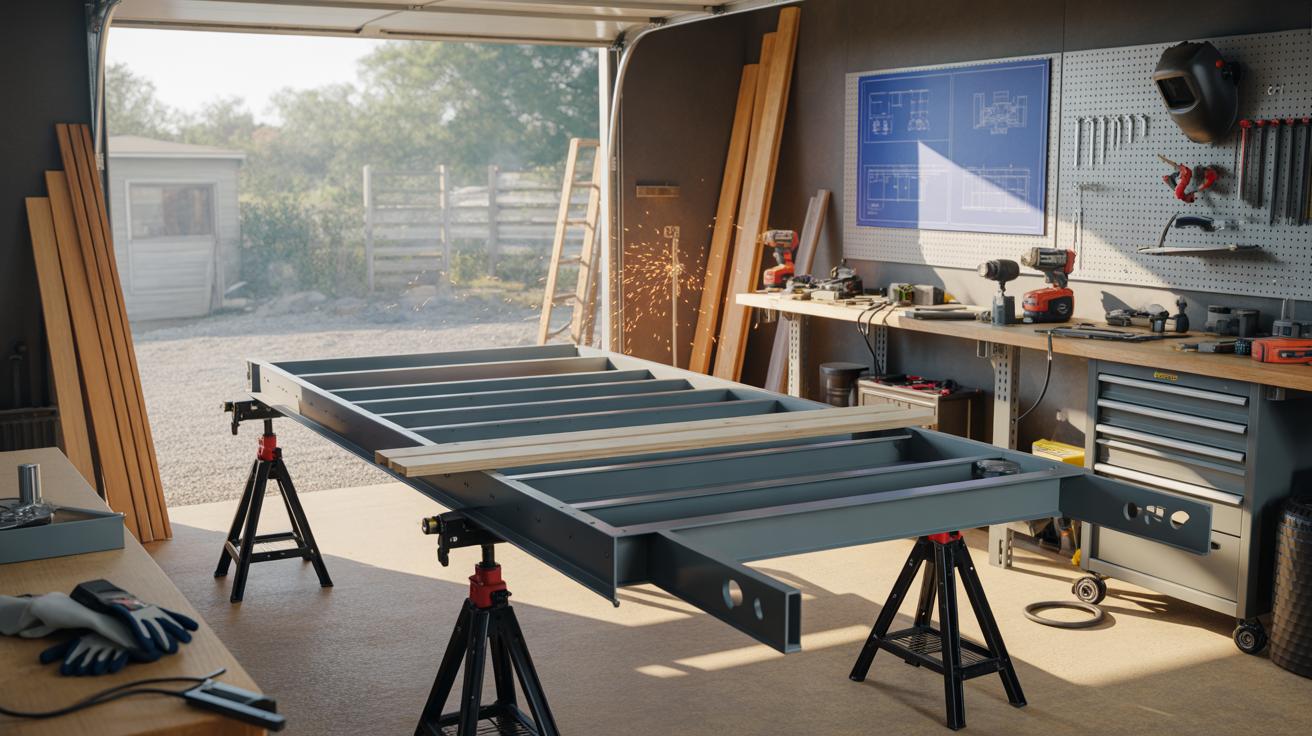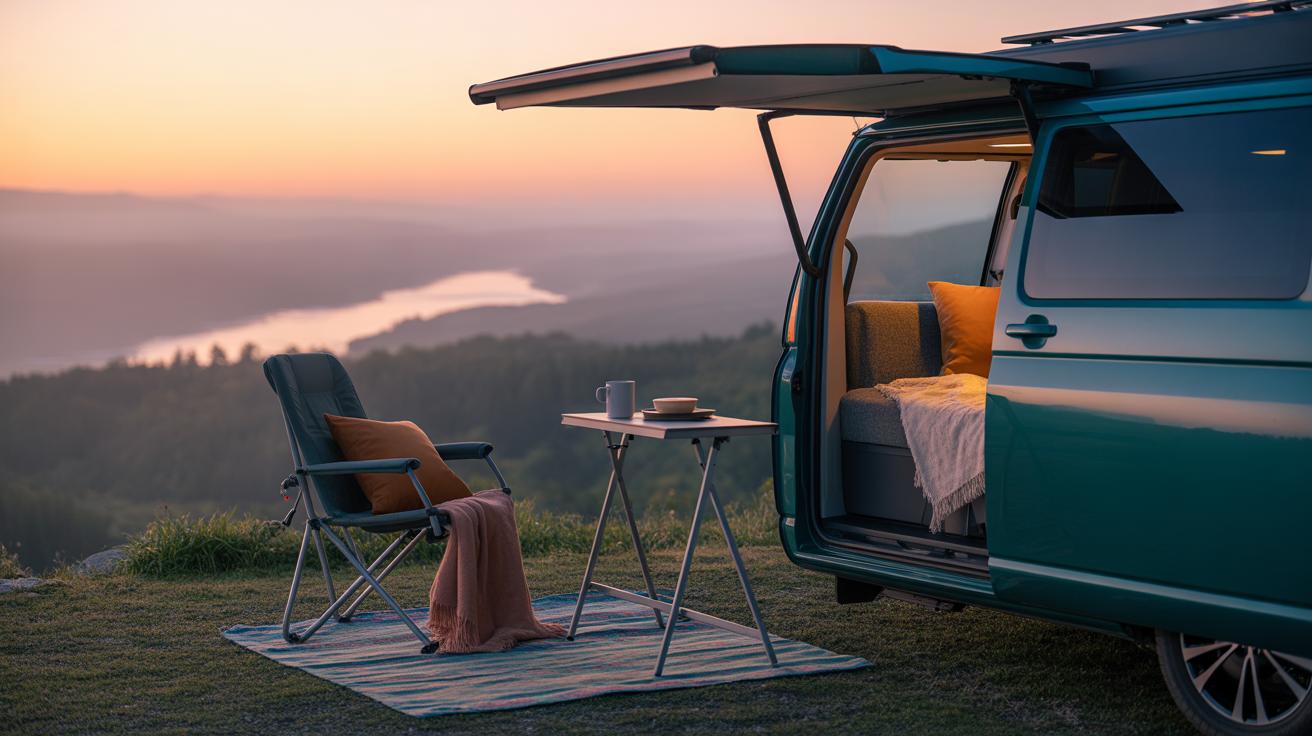Introduction
Living in a camper means working with less space. It pushes you to find smart ways to save room. Space Saving Hacks For Practical Camper Living Solutions can help you live comfortably without feeling cramped. These hacks make your camper feel bigger and more useful.
Camper living is about making the best use of every inch. The tips in this article will show you how to organize, store, and use your camper space better. You will find easy hacks for storage, furniture, and more that fit right into your camper life.
Planning Your Camper Layout For Space Saving
Careful planning of your camper’s interior layout can make or break how comfortably you live in such a tight space. It’s not just about cramming things in but thinking through how you move, store, and live daily. You want to avoid that awkward shuffle where every step feels cramped or every cupboard door bumps into something. Taking measurements seriously is the first and often overlooked step. Don’t estimate—measure every nook and cranny, because even a couple of inches can make a difference.
Designing areas for both living and storage means you’re consciously deciding where things belong before they find a home. I once tried to fit a fold-away table without considering legroom—big mistake. Sketching or mapping out zones for sleeping, cooking, relaxing, and storage beforehand helps you stay organized and leaves enough room to move around. Trust me, a clear path makes living more bearable.
Measuring And Designing Space Smartly
First, get a tape measure and note down the length, width, and height of your camper’s interior. Don’t forget about obstacles like wheel wells or cabinets that stick out. You might think you’ll “eyeball” an arrangement, but those rough guesses rarely work well in such a confined space.
Once you have your numbers, start sketching. Even a simple grid on graph paper works. Mark fixed elements—windows, doors, appliances—and think about how you use the camper throughout the day. Will you prepare meals while someone else relaxes? Do you need an open floor for yoga or a dining space? Visualizing these helps you avoid surprises later.
Some apps can help, like SketchUp or Roomstyler. They let you drag furniture pieces, rotate them, and get a sense of scale without lifting a tool. I’ve found these easy to tinker with while sitting in the camper, making tweaks on the spot.
Zoning Your Camper For Comfort And Function
Dividing your camper into zones creates order and keeps chaos at bay. Think of separate areas for sleeping, cooking, relaxing, and storage. Without this, everything blends into a jumble, making it harder to find or use anything.
Try to dedicate spots, even small ones, for each activity. For example, a fold-down bed area isn’t just for sleep; it could double as storage underneath. A seating nook can also become a workspace or dining spot. But make sure these zones don’t block your movement. A clear path through the camper matters—bumping into things isn’t enjoyable.
Clear zones also help mentally—your brain can switch gears easily when the environment signals a different activity. It’s strange how much that matters. You might be able to sleep better or cook with less stress just because your space feels more organized.
Using Vertical Space Efficiently In Your Camper
When living in a camper, floor space feels like a precious commodity. That’s why making the most of vertical space—walls and ceilings—can really change how you experience your small home on wheels. It’s about more than just squeezing in more stuff; it’s about keeping your living area clear and things easy to find.
Hooks are a simple but underused way to keep everyday items accessible yet out of your way. For example, hanging your jackets or backpacks on a cluster of sturdy hooks near the door saves you from tripping over piles. Shelves aren’t just for books. Small ledges along walls can hold spices or toiletries, keeping counters free for other tasks.
Mounting storage above head height might seem risky, but when done right, it’s a game-changer. Lightweight bins or baskets secured on overhead racks work well for things you don’t need every day, like extra blankets or shoes. A bit of careful measuring and choosing the right fasteners ensures everything stays put, even on bumpy roads.
Small, loose items pose a special challenge. Mesh pockets, hanging bins, or nets clipped inside cabinets or on walls can hold keys, chargers, or utensils within easy reach. Since these keep your stuff visible and off surfaces, they help reduce that cluttered feeling. Isn’t it weird how something as simple as a hanging organizer can make you feel more in control, even when space is tight?
Choosing MultiFunctional Furniture
Furniture that does more than one thing changes the game in camper living. It’s about stretching every inch without feeling cramped—something I constantly wrestle with. Take sofa beds, for example. During the day, you have a place to sit, and at night, it becomes a bed. This switch happens without needing extra space, which feels like a win.
When picking sofa beds or fold-out tables, size really matters. A bulky piece might offer comfort but crush your cramped quarters. Opt for modest sizes, ones that fold or collapse. Styles with clean lines and light materials often blend better than heavy, ornate pieces—less visual clutter, you know? A fold-out table can serve as a dining spot but also a workspace or counter when pushed against a wall. That flexibility keeps your camper feeling more like a home and less like a storage unit.
Sofa Beds And Fold-Out Tables
Imagine a camper layout where your sofa turns into a bed in seconds. It saves you the hassle of moving cushions or mattresses around. Choosing the right style can be tricky though. If the bed is too short or narrow, you won’t sleep well. But if it’s too large, your living area shrinks—something I’ve learned the hard way more than once.
Fold-out tables do a similar job. They tuck away nicely when not in use, opening up floor space instantly. Some even double as storage units or nightstands. The key is picking designs that feel sturdy without taking over your room. Sometimes a wall-mounted fold-down table beats the free-standing ones, especially in tight spots.
Storage Ottomans And Foldable Chairs
Storage ottomans are another piece you might want to consider. They act as seats and hide away clutter at the same time. Stashing away blankets, shoes, or books keeps your camper neat. Plus, when friends visit, you have extra seating without needing more chairs.
Speaking of chairs, foldable ones can be lifesavers. They don’t hog space when you don’t need them and pull out quickly for meals or gatherings. Just make sure they’re comfortable enough to use regularly. I’ve found some foldable chairs to be too flimsy, which kind of defeats the point. Look for models that fold flat and store easily behind doors or under beds.
Choosing the right multi-functional furniture is a balancing act. Comfort, size, and practicality all play off each other. But when you get it right, your camper doesn’t feel crowded—it feels like it works with you.
Efficient Kitchen Storage Ideas
Your camper kitchen has to work hard. There’s little room for extra stuff, so organizing thoughtfully can make all the difference between a messy counter and a clean, usable space.
Stackable And Nesting Containers
Stackable containers are a lifesaver when space is tight. You can pile them neatly in cupboards or the fridge, freeing up spots for other essentials. Nesting containers—those that fit inside each other when empty—cut down on clutter when you’re not using them. Food stays fresher too because you can switch from bulky packaging to airtight plastic or glass containers.
For campers, lightweight yet durable materials work best. Think BPA-free plastic, silicone lids, or even sturdy glass if you’re willing to carry the extra weight. Sizes should be small to medium—too big takes up space, too small means juggling too many containers. I try to keep a few 1-cup, 2-cup, and 4-cup sizes on hand. It sounds a bit like juggling Tetris pieces, but nesting them saves a surprising amount of room.
Magnetic And Pull-Out Kitchen Organizers
Installing a magnetic strip on a wall or inside a cabinet door is a sneaky way to store knives and metal utensils without wasting drawer space. It keeps everything visible and accessible. Sure, you might worry about safety, but with the right installation, those strips hold firmly and keep things tidy.
Pull-out racks for spices or pots save awkward drawer space and stop you from digging around aimlessly. They slide out so you can see everything clearly at once—a small upgrade with a big payoff. I once underestimated how much easier cooking could be when I switched to pull-out spice racks. Suddenly, no more blind fishing for the oregano jar! If you’re tight on drawer space, these racks can free things up for utensils or cleaning supplies.
Creative Bedding Solutions To Save Space
Foldable And Wall-Mounted Beds
Foldable beds like Murphy beds or wall-mounted sleepers turn your sleeping area into usable living space during the day. The mechanism usually involves hinges and springs or pistons that make it easier to lift the bed vertically against the wall. When closed, these beds free up significant floor area—think of a whole bed disappearing into the wall, leaving room for a table or extra seating. You might feel a bit skeptical about the sturdiness initially, but many models hold up well and are surprisingly simple to operate.
Sometimes, the bed folds down from a cabinet-like enclosure, revealing a mattress that’s ready to use in seconds. Other designs flip up from the floor, resting horizontally until you need them. This approach might not suit every camper, especially those who resist assembly routines, but if you can get used to it, the extra space gained is hard to beat.
Under-Bed Storage Options
Under your sleeping area is often wasted space waiting to be put to work. Boxes and organizers designed to slide under beds keep things neat—you could store spare bedding, seasonal clothes, or shoes here. I found clear plastic bins especially handy because you can peek inside without digging through everything. Some bins come with wheels, making it easier to pull them out from tight spots.
Think about the items you use less frequently and tuck those away under the bed. Clothes or camping gear that don’t need daily access are perfect candidates. If you’re worried about dust, using vacuum-sealed bags can protect fabrics while reducing bulk. Sometimes, it’s a bit of a balancing act—too much stuff under the bed might feel cluttered, but leaving it empty is just wasted potential.
Organizing Clothes And Personal Items
Living in a small camper means every inch counts, especially when it comes to storing clothes and personal items. One method that often surprises people is rolling clothes instead of folding them. Rolling reduces bulk and fits more into drawers or shelves. You start by laying the item flat, smoothing out wrinkles, then tightly rolling from one end to the other. T-shirts, jeans, and even pajamas work well this way. It makes it easier to see what you have without digging around—a simple trick I wish I’d used sooner.
Vacuum bags come in handy for seasonal or bulky clothes. You just place items inside, seal the bag, and remove the air with a vacuum or pump. This shrinks the volume dramatically. Though, it can be a bit annoying when you need something quickly since everything’s packed tight. Still, they free up valuable storage space for items you won’t use every day.
Hanging organizers can transform cramped closets and cubbies. They’re great for shoes, scarves, and accessories—things that don’t fold well. Think of cloth pockets or small compartments you hang on a rod or door. It’s like adding extra shelves without construction. Plus, sorting stuff becomes less of a hassle, although it might look a little cluttered if you’re not careful.
Have you tried mixing these ideas? Rolling clothes inside vacuum bags or organizing frequently used items in hanging pockets can keep your camper closet surprisingly neat. It’s about finding what fits your routine and space… even if it means tweaking along the way.
Maximizing Bathroom Space In A Camper
Compact Fixtures And Space-Saving Designs
Camper bathrooms are notoriously tiny, so picking the right fixtures is key. Small sinks with shallow basins can save precious inches without feeling too cramped. Sometimes, a corner sink fits better than a typical straight one, turning wasted space into useful spots. When it comes to toilets, low-profile or cassette models take up less room and work well in tight quarters. Shower units can be tricky—curved or folding designs help, but you’ll want to check if your camper’s plumbing supports them.
Choosing fixtures that suit your exact camper layout matters. A standard sink or toilet might look fine on paper but feel suffocating in real life. I once swapped a bulky vanity for a narrower unit, and the extra elbow room made a big difference—just a small change, but it really opened things up.
Utilizing Corners And Doors For Storage
Corners rarely get the credit they deserve. Corner shelves can hold toiletries or small towels and keep them within reach without cluttering the limited counter areas. They make use of what would otherwise be dead space. Over-door organizers are another smart move. Hang racks or pouches behind the bathroom door to store items like brushes, soaps, or even cleaning supplies.
These spots aren’t obvious storage at first glance, but they really help keep things off the sink and floor. You might wonder if these additions feel too crowded, but if chosen carefully, they blend in and free up the spots you do use all the time. It’s about fitting your stuff where it makes the most sense, even if it means looking a little unconventional.
Maintaining ClutterFree Living On The Road
Daily Cleaning And Organizing Habits
Keeping your camper tidy every day doesn’t have to feel like a chore. Small actions, repeated often, make a big difference. For instance, wiping kitchen and dining surfaces right after use stops crumbs and spills from piling up. It’s not about deep cleaning—just a quick swipe with a cloth or paper towel. Putting things back immediately also helps avoid clutter. If you leave your gear scattered, it’s easy for mess to sneak in before you realize it.
Some days, you might skip these habits, and that’s okay. But almost always, even a few minutes spent tidying prevents problems later. You could create a simple checklist if you want, but sometimes just sticking to routines like “clean as you go” works fine. It keeps the camper feeling lighter and less stressful without needing a big effort every day.
Regular Decluttering And Smart Packing
Decluttering doesn’t have to happen only when things get overwhelming. Setting a regular schedule, like once a month, helps keep only what you truly need on board. I find it useful to ask myself: “Did I use this in the last month?” If not, maybe it’s time to let it go. Fewer items mean less to manage, less to clean, and fewer spots for mess to hide.
Packing strategically from the start also reduces clutter. Group similar items together in labeled bins or bags. Avoid overpacking by planning for flexibility—pick versatile clothes and multi-use tools. Try to limit duplicates unless absolutely necessary. And don’t forget to adjust your load based on your trip length and what amenities you’ll encounter. Smart packing can actually save time and stress once you’re on the road.
Using Outdoor Space To Extend Living Areas
When your camper feels a bit tight, looking outside can often solve the space problem better than rearranging inside. Outdoor areas offer unexpected room if you use them smartly. A pop-up awning is not just for shade—it creates a defined space for relaxing or cooking without feeling cramped. Setting one up might take a moment longer than you expect, especially on uneven ground, but it pays off. Anchoring it well and adjusting the angle can keep it sturdy even if the wind picks up.
Portable furniture makes a real difference. Folding tables and chairs that collapse small enough to slip into storage don’t just fill the space—they redefine it. Imagine sitting outside on a calm morning with a cup of coffee at a table you can pack away when you’re ready. Outdoor storage boxes also help keep your gear accessible yet out of sight, stopping clutter from creeping back inside. I find them especially handy for things like grills or garden tools that you want close but don’t want cluttering the camper.
All these pieces give you extra living zones without needing to stretch your camper’s walls. But think over how often you’ll use each item. Carrying too much “just in case” might actually make life harder. It’s a balance, but when done right, the outdoors truly becomes part of your camper’s living room.
Conclusions
Small spaces in campers can be tough but using space-saving hacks changes the game. By using smart storage, multi-functional furniture, and good organization, you can use your camper space fully. These tips help you enjoy your life on the road more.
Space Saving Hacks For Practical Camper Living Solutions make camper living practical and fun. You no longer have to worry about space issues. With the right approach, your camper can be a cozy, efficient home no matter where you go.




















